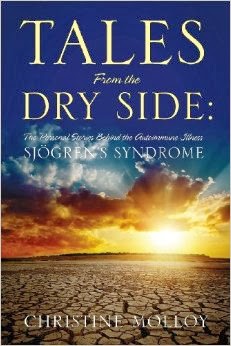I think it has been a little while since I have posted an update about how I have been doing medically. There are many reasons for that; I was away on my honeymoon, I have been tied up with the book being published, and most importantly, I have been feeling better.
I started back on Plaquenil sometime in August as it was clear that the alternative medicine treatments alone were not doing the trick. They help, a lot, but they were not enough to keep me from having more complications, such as with my bladder. I wasn’t doing terribly, but there was a lot of room for improvement, hence why I went back on Plaquenil. I never thought Plaquenil did much for me in all the years I was taking it, which is why I stopped it in February, but I may have been mistaken on that.
By the middle of September, I was still having a lot of issues with increased joint pain, especially in my shoulders, hips, and hands, swollen lymph nodes that were causing some alarm, fatigue, and this new interstitial cystitis issue with my bladder was still not under control. I had gotten a lot of relief with the bladder issues after going in for surgery to have a hydrodistension done, but my symptoms were starting to return, although not nearly as severe as in previous months. My urologist and I came up with a plan to start bladder instillations every two weeks for twelve treatments…at a hospital two hours away from me. Oh, the joy!
Since I was leaving on my honeymoon for Disney (we were married in May) at the end of September, I decided to heed my rheumatologist’s advice and go back on prednisone, hopefully for the short-term. About eleven days before we left, I started on 20mg once a day of prednisone. Within 72 hours, the change was dramatic. My joint pain was resolved, I had more energy, ALL of my bladder symptoms were completely gone, and within another week, my lymph nodes were back down to an almost normal size. We even decided to hold off on the bladder instillations.
Now, I have a long and intense history with prednisone use which you can read about if you go back to the main page of this blog and click on the prednisone tag under “labels”. It has been quite a while since I needed to be on prednisone for longer than a week and notoriously, I have a lot of side effects which make me want to get off of it as soon as possible. This run with it, initially, was much easier and it makes me wonder if my alternative medicine therapies had anything to do with that. I was getting so much accomplished; I even took up running! I did have to stop my alternative therapy, low-dose naltrexone, because I thought I had too much energy and because both medications give me insomnia, I wasn’t sleeping well. Coming off the low-dose naltrexone helped tremendously.
I was doing so well that it made me wonder if maybe the risk of staying on a higher dose of prednisone long-term was worth it. That whole quality of life over quantity thing and all. I began to realize that if I could stay on this dose, I could probably start thinking about going back to work part-time, or at least on a per-diem basis. After a few weeks, I weaned the dose to 15 mg and was still doing well, and then went to 12.5 mg and then 10mg. Within a week of being on 10 mg, I really began to struggle with my symptoms again so I went back to 15 mg, knowing that I had a rheumatologist appointment coming up soon.
Two weeks before my rheumatology appointment, things began to get tougher for me. I was still feeling good on the 15 mg, but I had put on a lot of weight, despite exercising 4-5x/week. Fifteen pounds to be exact…in less than two months. That, I could deal with. More concerning were the mood swings I was beginning to have. I was struggling (and still am) more than people knew with depressive mood swings, anxiety, and becoming easily frustrated. I tried to keep my head down, but it was wearing on me. The good thing about having been on prednisone so often is that I knew it was medication related, and I have a lot of experience at managing these symptoms. But, it was kind of putting a big damper on that whole “better quality of life” thing. I have had bad prior experiences with psychiatric medications and for me, they are not the answer, so I worked on increasing my exercise, exposure to sunlight, stress management, etc.
I did talk to my rheumatologist last week at my appointment about the side effects. My blood pressure was also elevated and the only time that happens is when I am on larger doses of prednisone. She told me it was time to come down on the prednisone. I will be honest, I was very upset. I explained to her that I tried that already and after much conversation, she made me realize that I came down on the dose too quickly. I have a bad habit of trying to do things my way and you know what? I am sick of it. Historically, I get no benefit from being on less than 15 mg of prednisone but this time, I am doing it her way. Not 50% her way, or 80% her way, but 100% her way. So we are weaning the prednisone down by 1 mg every two weeks until I get to 10 mg and then we wean it 1 mg every MONTH. The goal is to get on as low a dose as possible…or even off of it.
I don’t have any other treatment options at the moment besides my Plaquenil and alternative treatments. We had discussed the possibility of enrolling in a clinical trial for a new medication, but I was disqualified from entering into the study because of my lymphoma and radiation treatment history from seventeen years ago.
I am scared and I am discouraged. I don’t want to go back to feeling the way I did over this past summer, or even last year. The only analogy I can think of is that it is like being blind…getting your vision back for a few months…and then being told you will likely be blind again in a couple of weeks or months. Yes, I know being blind is extremely difficult, but it is the only analogy I can think of to explain the terrible feeling that comes with it. Don’t get me wrong, I am SO grateful for these past two months. I have accomplished much and literally have made the most out of every single day I have felt better. I have had a few wonderful adventures and done things I never thought possible. But at this point, I have to trust the opinion of my doctor and that being on prednisone at the dose I was on, on a long-term basis, is not in my best interest. I have to have hope that maybe I will not backslide too much.
But what is in my best interest? Struggling to get through every day? Going on and off prednisone every couple of months to quiet things down temporarily? Wondering if the back and forth on the prednisone is better or worse for me in the long run as compared to just staying on it? There are no clear answers and unfortunately, my doctor and I do not have a crystal ball to predict the future. So I am hanging on tight to my faith as I begin the slow journey of cutting back my prednisone. I will have to tighten up on my diet, self-care, and likely restart my low-dose naltrexone.
The good news is, I will likely lose some weight and my moods will definitely even out. I am sure my husband will appreciate the latter.
Faith.
Hope.
Courage.
And here we go….

